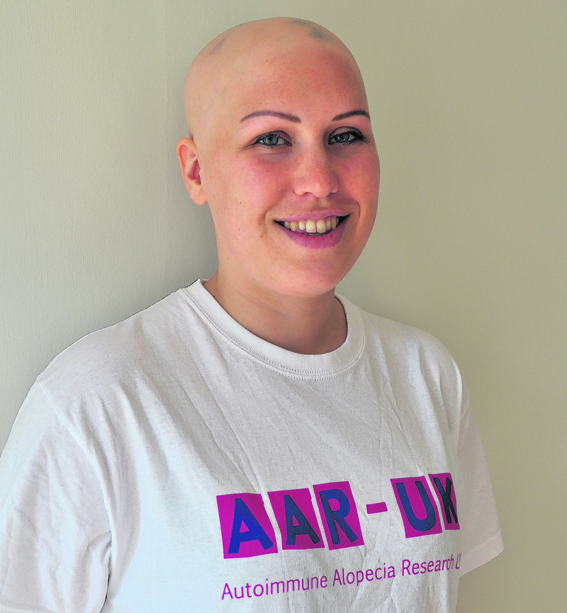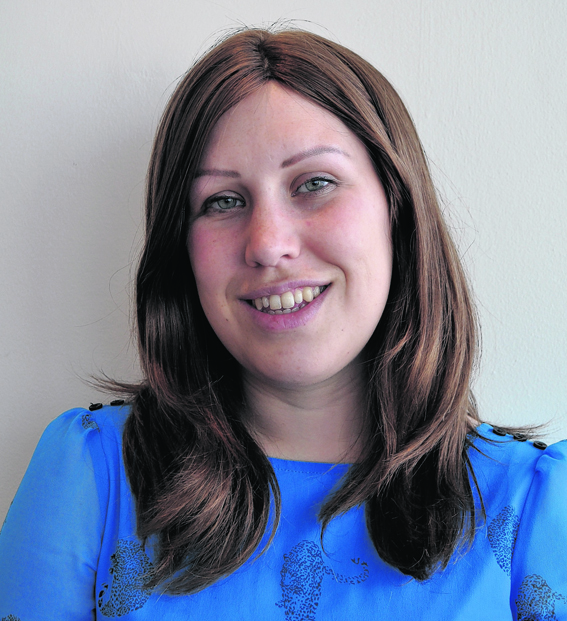Hello. I’m a Morayshire lass (I grew up in Longmorn and went to school at West End Primary, Aberlour House and Gordonstoun), and now live and work in London as an advertising manager for a classical music and performing arts publishing company.
I have had alopecia for almost ten years now and finally feel able to speak up about it.
Alopecia is an autoimmune disease which occurs when the immune system attacks healthy hair follicles, causing permanent hair loss. I have had alopecia since I was 18 (I am now 27).
My hair began to fall out the summer after I left school. Three months later, I was completely bald.
 Losing my hair was an extremely traumatic experience, as I didn’t know or understand what was happening to my body, and was unable to control it. Every time I brushed my hair and found clumps in my hairbrush or realised that there was hair all over my pillow, I felt sick, and if I stayed at a friend’s house I would have to run around cleaning up after myself because I was so embarrassed that someone would find out!
Losing my hair was an extremely traumatic experience, as I didn’t know or understand what was happening to my body, and was unable to control it. Every time I brushed my hair and found clumps in my hairbrush or realised that there was hair all over my pillow, I felt sick, and if I stayed at a friend’s house I would have to run around cleaning up after myself because I was so embarrassed that someone would find out!
Eventually, when I looked in the mirror and realised that I had huge patches all over my head, I had to admit to myself that something was seriously wrong.
That’s when I was diagnosed with alopecia. Although not damaging to physical health, alopecia can have severe effects on quality of life and emotional health.
Doctors could unfortunately do very little to help, as there is no known cure or effective treatment for alopecia, so I was left to get on with it as best I could.
For the first few months after my diagnosis I started wearing headscarves, and still managed to go travelling with a friend around Europe that first summer. But as I lost more and more hair, the scarves got bigger and bigger, and I began to get increasingly stressed about my appearance. I no longer recognised myself in the mirror, and would tear up photographs because I was so ashamed of how I looked.
Even worse was losing my eyelashes and eyebrows, which completely changed the look of my face, and made me feel less feminine. Without any hair, I felt like an alien in my own skin.
About three months in, I was persuaded that it was time to explore the option of getting a wig. For me, this was a totally foreign concept – the only time I had ever worn a wig was for fancy dress and I couldn’t imagine having to wear one all the time!
Trying one on for the first time was a bizarre experience, and even the word ‘wig’ felt strange to me. Although I must admit, trying them on in the hairdressers turned out to be more fun than I thought it would be – I felt like Samantha in Sex and the City!
Wearing wigs had its ups and downs, as I was pleased to be able to hide behind them but often I would be racked with insecurity that people knew and were talking about me behind my back. I also felt less free, and wasn’t able to do things like going swimming or on rides at a theme park, without worrying that my wig would come flying off and embarrass me.
Over the years, I have experimented with wigs of various colours, lengths and shapes, from auburn and heavily fringed to peroxide blonde to my current darker tone. The quality of my wigs has gradually improved, as I have found out more and more about what is available, where to source them and how to get them cut.
I also started getting my eyebrows tattooed on with semi-permanent makeup, which is a huge relief as pencilling them in every day got frustrating pretty quickly.
With time and incredible support from my friends and family, I have grown more confident about my appearance, however I still feel the need to wear a wig every day.
I have always found telling people about my alopecia really difficult, even though I know it is nothing to be ashamed of. Many people have no idea that this is not my real hair, including colleagues I sit next to every day at work!
Undertaking the challenge of Wig Free Week is a huge step for me, but I hope it will be a liberating one.
WIG FREE WEEK
I will be going wig-free for a week from Monday, October 26 to November 1 to raise money for Autoimmune Alopecia Research UK.
Wig Free Week will be the first time I have ever gone out in public without my wig for an extended period of time, and the first time that I have shared photographs of my bald head.
AAR-UK is a fantastic charity, run by two inspirational women with alopecia, who are working to set up the UK’s first bio bank for autoimmune alopecia research. The data they collect will prove invaluable to finding out what causes alopecia and may one day help find a cure to help sufferers across the world.
TO FIND OUT MORE
My fundraising page: https://mydonate.bt.com/fundraisers/ruthswigfreeweek
My blog: https://livingwithalopeciablog.wordpress.com/
Autoimmune Alopecia Research UK website:
http://www.aar-uk.org/Welcome/
Bio bank research video: https://www.youtube.com/watch?v=KFVXGI5Yr64
#wigfreeweek
